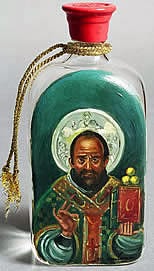The only recorded "meeting" of St. Nicholas and JPII was in the Italian city of Bari, a coastal and mercantile hotspot far away from Nicholas' original place of Apostolic service, Myra, in present day Turkey. His relics were taken away from monks of Myra by Italian merchants (c.1087). Consequently, a basilica was constructed in Bari which housed the stolen relics from Myra (all pictures on this post via St. Nicholas Center: www.stnicholascenter.org). JPII visited the Basilica di San Nicola in February of 1984.
Here is prolonged mysteriously a singular testimony of holiness, which has enlightened the hearts of millions of faithful of the East and the West. Here the memory of faith brings to life the presence, not extinguished by the death of a man who lived in the East between the third and fourth century, but found with magnificent expression of that special, unique kind of Christian genius that the Holy Spirit has given to the brothers of the East for the edification of the Church (Address of John Paul II at the Basilica di San Nicola, 26 Feb., 1984, Par #1)
The Pope refers specifically to the relics of Nicholas himself, which, despite having been stolen from Myra, still exude a healing "manna" that pilgrims seek after for healing ( all pictures on this post via St. Nicholas Center: www.stnicholascenter.org). The healing qualities extend beyond physical ailments. They touch upon actual ruptures in the Church, as JPII goes on to quote Pope Urban II:
Just remember the Synod of Bishops Greek and Latin, in 1098, presided over by Pope Urban II here in this church, 'ante corpus Blessed Nicolai' in an effort to give expression to the intuition of harmony not only possible, but recognized in the nature of the Church. (Address of John Paul II at the Basilica di San Nicola, Par #2).
A true testament to the holiness of St. Nicholas lies in the fact that although his remains were taken from Myra to Bari, his relics continue to work miracles by the power of God's grace. His holiness is not erased because of the theft committed by Italian merchants. Rather he is remembered by JPII as charismatic, and a leader chosen by God:
All that honors the Church of Bari, and pays tribute to St. Nicholas, gentle man - according to the portrait of him that it was delivered by tradition - full of unfailing energy; magnificent image of Christ, the bishop who defended the true faith, he loved righteousness, has protected the poor and the widows (ibid).
Of note also is his compassion for the impoverished, especially displayed in the story about his generosity toward the three daughters without dowries. That is why he is often displayed with three golden orbs (more commonly seen today as oranges placed in stockings). (all pictures on this post via St. Nicholas Center: www.stnicholascenter.org)
Why JPII does not specifically mention Christmas in his speech about St. Nicholas is hard to determine. The attention he draws to the Incarnation, in keeping with his theme of unity of Christians, suffices:And the Church, for her part - I noticed in my first Encyclical - 'sees. . . its fundamental task in ensuring that this union is renewed continually. The Church wishes to serve this single end: that each person can find Christ, in order that Christ may walk with each person the path of life, with the power of the truth about man and the world, contained in the mystery of the Incarnation and Redemption' (ibid).
He doesn't limit the influence of St. Nicholas to just Christmas, but extends it to the Redemption as well. By providing the gold needed for the daughters' dowries, Nicholas pointed to the payment of the Redemption wrought by Christ's blood. Likewise, by standing up against Arius at the council of Nicea, Nicholas firmly defended the Incarnation of the Word of God as well. JPII celebrated Mass in the Basilica di San Nicola, and brought all of these elements together in the sacrifice of Jesus to the Father. St. Nicholas was there in his relics and in spirit.
St. Nicholas of Myra is mentioned in Dante's Divine Commedy in Purgatorio XX "...Nicholas unto the maidens gave,/In order to conduct their youth to honour"


No comments:
Post a Comment